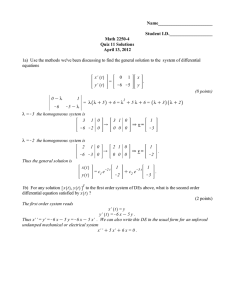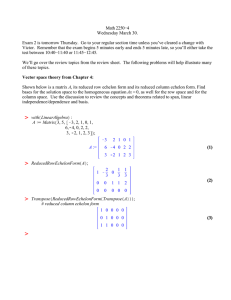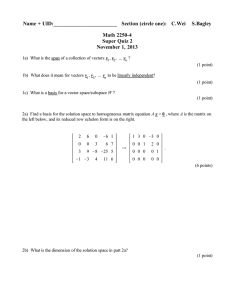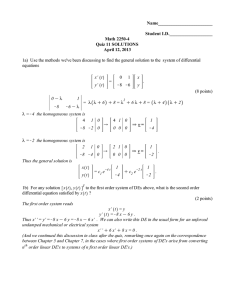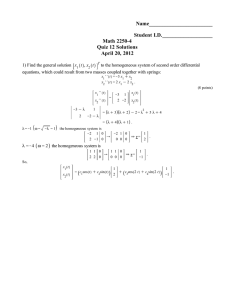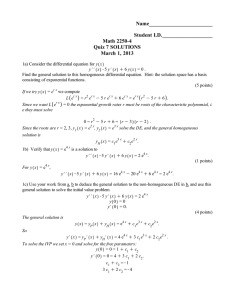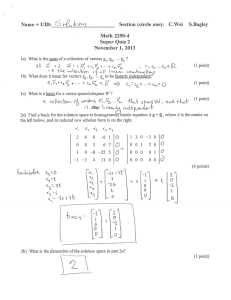Math 2250-010
advertisement
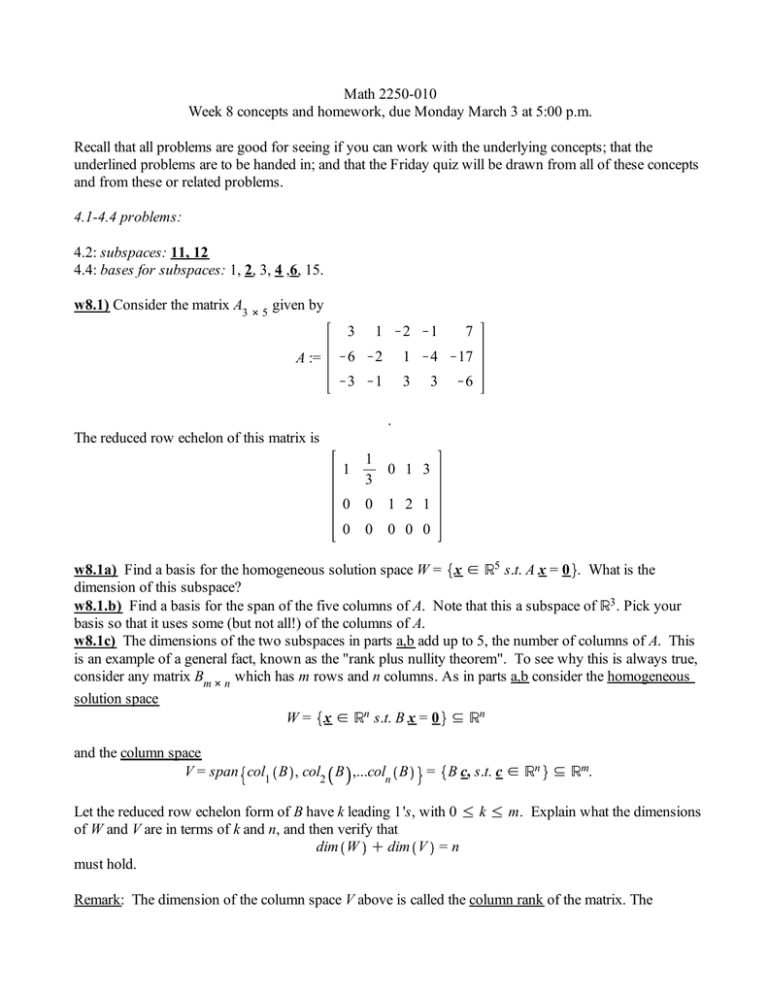
Math 2250-010 Week 8 concepts and homework, due Monday March 3 at 5:00 p.m. Recall that all problems are good for seeing if you can work with the underlying concepts; that the underlined problems are to be handed in; and that the Friday quiz will be drawn from all of these concepts and from these or related problems. 4.1-4.4 problems: 4.2: subspaces: 11, 12 4.4: bases for subspaces: 1, 2, 3, 4 ,6, 15. w8.1) Consider the matrix A3 # 5 given by 3 A := 1 K2 K1 7 K6 K2 1 K4 K17 K3 K1 3 3 K6 . The reduced row echelon of this matrix is 1 1 3 0 1 3 0 0 1 2 1 0 0 0 0 0 w8.1a) Find a basis for the homogeneous solution space W = x 2 =5 s.t. A x = 0 . What is the dimension of this subspace? w8.1.b) Find a basis for the span of the five columns of A. Note that this a subspace of =3 . Pick your basis so that it uses some (but not all!) of the columns of A. w8.1c) The dimensions of the two subspaces in parts a,b add up to 5, the number of columns of A. This is an example of a general fact, known as the "rank plus nullity theorem". To see why this is always true, consider any matrix Bm # n which has m rows and n columns. As in parts a,b consider the homogeneous solution space W = x 2 =n s.t. B x = 0 4 =n and the column space V = span col1 B , col2 B ,...coln B = B c, s.t. c 2 =n 4 =m. Let the reduced row echelon form of B have k leading 1's, with 0 % k % m. Explain what the dimensions of W and V are in terms of k and n, and then verify that dim W C dim V = n must hold. Remark: The dimension of the column space V above is called the column rank of the matrix. The homogeneous solution space W is often called the nullspace of A, and its dimension is sometimes called the nullity. That nomenclature is why the theorem is called the "rank plus nullity theorem". You can read more about this theorem, which has a more general interpretation, at wikipedia (although the article gets pretty dense after the first few paragraphs). w8.2) Recall that because of how matrix multiplication works, column dependencies for a matrix A, i.e. c1 col1 A C c2 col2 A C...C cn coln A = 0 are equivalent to homogeneous solutions c = c1 , c2 ,..., cn A c = 0. T to the matrix equation As we discuss in class using the notes from Monday February 24, this implies that column dependencies in A correspond exactly to column dependencies in the reduced row echelon form of A. This fact, and the four conditions that a reduced row echelon form matrix must satisfy, means that one can deduce the reduced row echelon form of a matrix A by knowing the column dependencies of A. Thus each matrix has only one reduced row echelon form no matter the order of row operations that one uses to compute it. As an example of this fact, let a matrix A4 # 6 have the following list of column dependencies: col1 A = 0 (i.e. column one is linearly dependent). col2 A s 0 (i.e. column two is linearly independent) col3 A = 2 col2 A col4 A is not a linear combination of col2 A (i.e. not a scalar multiple) col5 A = 3 col2 A K col4 A col6 A is not a linear combination of col2 A , col4 A . What must the reduced row echelon form of A be? Explain. 5.1 Solving initial value problems for linear homogeneous second order differential equations, given a basis for the solution space. Finding general solutions for constant coefficient homogeneous DE's by searching for exponential or other functions. Superposition for linear differential equations, and its failure for nonlinear DE's. 1, 6, (in 6 use initial values y 0 = 10, y# 0 =K5 rather than the ones in the text), 10, 11, 12, 14 (In 14 use the initial values y 1 = 1, y# 1 = 7 rather than the ones in the text.), 17, 18, 27, 33, 39. w8.3a) In 5.1.6 above, the text tells you that y1 x = e2 x, y2 x = eK3 x are two independent solutions to the second order homogeneous differential equation y##C y#K6 y = 0. Verify that you could have found these two exponential solutions via the following guessing algorithm: Try y x = er x where the constant r is to be determined. Substitute this possible solution into the homogeneous differential equation and find the only two values of r for which y x will satisfy the DE. (See Theorem 5 in the text.) w8.3b) In 5.1.10 above, the text tells you that y1 x = e5 x, y2 x = x e5 xare two independent solutions to the second order homogeneous differential equation y##K10 y#C 25 y = 0. Follow the procedure in part a of trying for solutions of the form y x = er x, and then use the repeated roots Theorem 6 in the text, to recover these two solutions. 5.2 Testing collections of functions for dependence and independence. Solving IVP's for homogeneous and non-homogeneous differential equations. Superposition. 1, 2, 5, 8, 11,13, 16, 21, 25, 26 Here are two problems that explicitly connect ideas from sections 5.1-5.2 with those in chapter 4: w8.4) Consider the 3rd order homogeneous linear differential equation for y x y### x = 0 and let W be the solution space. w8.4a) Use successive antidifferentiation to solve this differential equation. Interpret your results using vector space concepts to show that the functions y0 x = 1, y1 x = x, y2 x = x2 are a basis for W. Thus the dimension of W is 3. 1 w8.4b) Show that the functions z0 x = 1, z1 x = x K 3, z2 x = x K 3 2 are also a basis for W. 2 Hint: If you verify that they solve the differential equation and that they're linearly independent, they will automatically span the 3-dimensional solution space and therefore be a basis. w8.4c) Use a linear combination of the solution basis from part b, in order to solve the initial value problem below. Notice how this basis is adapted to initial value problems at x0 = 3, whereas for an IVP at x0 = 0 the basis in a would have been easier to use. y### x = 0 y 3 = 17 y# 3 = 24 y## 3 = 5. w8.5) Consider the three functions y1 x = cos 3 x , y2 x = sin 3 x , y3 x = sin 3 x C p 6 . a) Show that all three functions solve the differential equation y##C 9 y = 0 . b) The differential equation above is a second order linear homogeneous DE, so the solution space is 2Kdimensional. Thus the three functions y1 , y2 , y3 above must be linearly dependent. Find a linear dependency. (Hint: use a trigonometry addition angle formula.) c) Explicitly verify that every initial value problem y##C 9 y = 0 y 0 = b1 y# 0 = b2 has a solution of the form y x = c1 cos 3 x C c2 sin 3 x , and that c1 , c2 are uniquely determined by b1 , b2 . (Thus cos 3 x , sin 3 x are a basis for the solution space of y##C 9 y = 0: every solution y x has initial values that can be matched with a linear combination of y1 , y2 , but once the initial values match the solutions must agree by the uniqueness theorem, so y1 , y2 span the solution space; y1 , y2 are linearly independent because if c1 cos 3 x C c2 sin 3 x = y x h 0 then y 0 = y# 0 = 0 so also c1 = c2 = 0.) d) Find by inspection, particular solutions y x to the two non-homogeneous differential equations y##C 9 y = 27, y##C 9 y =K18 x Hint: one of them could be a constant, the other could be a multiple of x . e) Use superposition (linearity) and your work from c,d to find the general solution to the nonhomogeneous differential equation y##C 9 y = 27 K 18 x . f) Solve the initial value problem, using your work above: y##C 9 y = 27 K 18 x y 0 =0 y# 0 = 0 .
